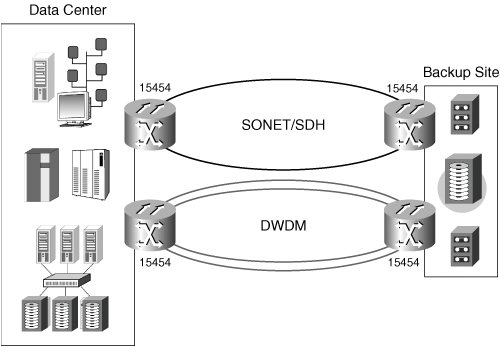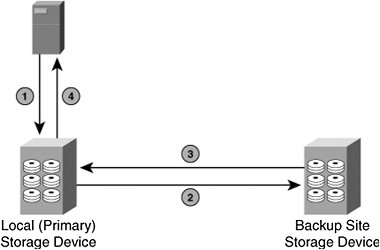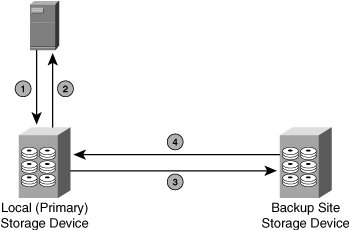SAN Review
| In simple terms, a SAN is a network infrastructure deployed between servers and storage resources. For example, one solution is to provide a storage network where Fibre Channel (FC) switches, such as the Cisco MDS 9000, can be interconnected over a 15454 network. The 15454 network interfaces with the FC switches, as shown in Figure 8-1. Figure 8-1. SAN Extension Example A SAN is normally a dedicated network optimized for the exchange of large amounts of data within the data center to support better utilization of available storage and to provide for disaster-recovery solutions. Companies typically have two data centers, one that is active and one in standby, in case the active data center fails. The SAN enables the two data centers to be synchronized so that the standby center has up-to-date information. A SAN creates a dedicated link between the server and storage devices that must follow certain requirements, such as low delay, high bandwidth, and high reliability. FC and Enterprise Systems Connection (ESCON) switches are used at the local data centers to provide access to storage discs. Note Network attached storage (NAS) is similar to a SAN but uses files instead of blocks. Blocks of data represent a more granular representation of the data, compared to files. It's similar to the concept of Microsoft Windows, in which files represent data. In addition, the data is stored on your hard disk in a much more granular format, which you can think of as blocks. SAN replicates the data between the servers and storage devices at the block level instead of the file level. Databases, such as Oracle, store data as blocks. This method of replicating data at the block level makes more efficient use of the storage devices than the file replication method used by NAS. SAN ProtocolsThe most commonly used SAN protocols include these:
You can use different network technologies, such as Dense Wave Division Multiplexing (DWDM), SONET, and IP, to transport these SAN protocols. SONET or DWDM?Multiple methods exist for transporting SAN protocols between geographical locations. You can use a SONET-based infrastructure in which you can add a storage extension card in the existing equipment located at the data centers. This is possible when the SONET rings have been built out using the ONS 15454. In this scenario, you can use the FC-MR-4 card to extend the FC or FICON between the locations that contain the servers and the storage devices. Alternatively, you can use a DWDM-based infrastructure. This is applicable when high density and high bandwidth are needed between the server and storage device locations. The ONS 15454 supports this environment when the ONS 15454 is used as the DWDM transmission network and is used to add the wavelength service, such as SAN extension, on the DWDM network. In this scenario, you select the appropriate Cisco 15454 transponder card that supports the SAN protocol, the number of SAN ports, and the bandwidth required between the desired locations. The section "A Single-Chassis SAN Extension Solution: ONS 15454," later in this chapter, lists the available transponder cards used for SAN extension on the 15454. Note Both solutions, SONET and DWDM, offer quick protection on the order of 50 ms. Data Storage MirroringThe time it takes to back up storage data and the time it takes to recover from a failure are critical components to many companies, especially ones in the financial marketplace. In the past, tapes were used to replicate the storage data and were physically moved off-site. This process of backing up data is unacceptable to many companies today because of the slow recovery time. Today, large companies such as banks require an almost immediate recovery of their services. This can be accomplished by mirroring the data between locations, known as data replication or data mirroring, and it is the primary reason businesses want to transport storage data between data centers. Two main types of data replication exist: synchronous and asynchronous.
Synchronous Data ReplicationFor synchronous data replication, the data is referred to as being "mirrored" between these two sites. When you want to achieve high availability, you must immediately switch over to a backup storage device that contains the exact data as the primary data device. You use synchronous data replication to achieve this. However, it is important to understand that latency between the data centers is critical to the data-replication application. Synchronous data replication is sensitive to end-to-end latency because an application running on the server must wait until it receives an acknowledgment that the data has been replicated on the primary and the backup storage devices. The data-replication application will not work properly if this time is too long. Figure 8-2 shows an example of synchronous data replication. Figure 8-2. Example of Synchronous Data Replication Using SONET or DWDM Another type of synchronous mirroring occurs when you mirror the application in addition to the storage device. GDPS, a protocol developed by IBM, implements this capability. GDPS requires that special control and timer links be established between locations, in addition to transporting the storage protocol. Cisco transponder cards support this environment. For synchronous replication, the following events occur:
Figure 8-3 shows how these four steps are carried out. Figure 8-3. Synchronous Data Replication Events Asynchronous Data ReplicationAsynchronous data replication disconnects the primary write operation from the remote write operation. In other words, the application writes the data to primary storage and continues with the next operation without pausing to wait for confirmation that data has been successfully written to the secondary site. Asynchronous replication is typically used where synchronous data replication is not practical, especially in long-haul applications in which the end-to-end delay is too much for synchronous mirroring. Unlike synchronous data replication, asynchronous is not latency sensitive and can accommodate a certain amount of delay in the network and data loss. Therefore, you can use asynchronous data replication across longer distances. You must determine the distances that the storage devices can support using synchronous or asynchronous applications. This helps determine the type of network that can support SAN extension. For asynchronous replication, the following events occur:
Figure 8-4 shows how these four steps are carried out. Figure 8-4. Asynchronous Data Replication Events |
EAN: 2147483647
Pages: 140


